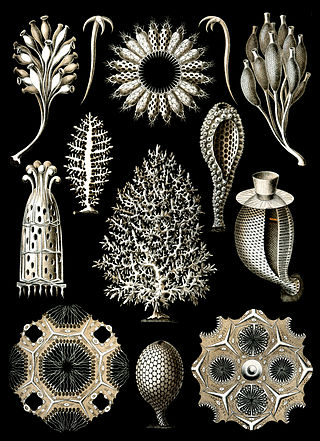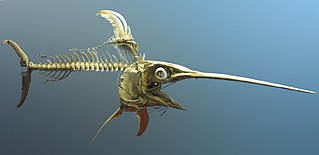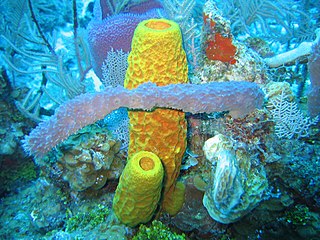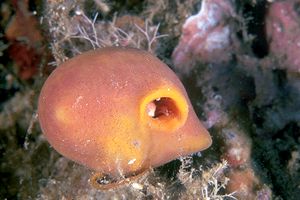
Sponges or sea sponges are members of the metazoan phylum Porifera, a basal animal clade and a sister taxon of the diploblasts. They are sessile filter feeders that are bound to the seabed, and are one of the most ancient members of macrobenthos, with many historical species being important reef-building organisms.

Hexactinellid sponges are sponges with a skeleton made of four- and/or six-pointed siliceous spicules, often referred to as glass sponges. They are usually classified along with other sponges in the phylum Porifera, but some researchers consider them sufficiently distinct to deserve their own phylum, Symplasma. Some experts believe glass sponges are the longest-lived animals on earth; these scientists tentatively estimate a maximum age of up to 15,000 years.

The calcareoussponges are members of the animal phylum Porifera, the cellular sponges. They are characterized by spicules made of calcium carbonate, in the form of high-magnesium calcite or aragonite. While the spicules in most species are triradiate, some species may possess two- or four-pointed spicules. Unlike other sponges, calcareans lack microscleres, tiny spicules which reinforce the flesh. In addition, their spicules develop from the outside-in, mineralizing within a hollow organic sheath.

The Venus' flower basket is a glass sponge in the phylum Porifera. It is a marine sponge found in the deep waters of the Pacific Ocean, usually at depths below 500 m (1,600 ft). Like other sponges, they feed by filtering sea water to capture plankton and marine snow. Similar to other glass sponges, they build their skeletons out of silica, which forms a unique lattice structure of spicules. The sponges are usually between 10 cm (3.9 in) and 30 cm (12 in) tall, and their bodies act as refuge for their mutualist shrimp partners. This body structure is of great interest in materials science as the optical and mechanical properties are in some ways superior to man-made materials. Little is known regarding their reproduction habits, however fluid dynamics of their body structure likely influence reproduction and it is hypothesized that they may be hermaphroditic.

An endoskeleton is a structural frame (skeleton) on the inside of an animal, overlaid by soft tissues and usually composed of mineralized tissue. Endoskeletons serve as structural support against gravity and mechanical loads, and provide anchoring attachment sites for skeletal muscles to transmit force and allow movements and locomotion.

Demosponges (Demospongiae) are the most diverse class in the phylum Porifera. They include greater than 90% of all species of sponges with nearly 8,800 species worldwide. They are sponges with a soft body that covers a hard, often massive skeleton made of calcium carbonate, either aragonite or calcite. They are predominantly leuconoid in structure. Their "skeletons" are made of spicules consisting of fibers of the protein spongin, the mineral silica, or both. Where spicules of silica are present, they have a different shape from those in the otherwise similar glass sponges. Some species, in particular from the Antarctic, obtain the silica for spicule building from the ingestion of siliceous diatoms.

Suberites domuncula is a species of sea sponge belonging to the family Suberitidae.

Sponge reefs are reefs produced by sea sponges. All modern sponge reefs are formed by hexactinellid sponges, which have an endoskeleton made of silica spicules and are often referred to as "glass sponges", while historically the non-spiculed, calcite-skeletoned archaeocyathid and stromatoporoid sponges were the primary reef-builders.

Clathrina coriacea is a species of calcareous sponge belonging to the class Calcarea and family Clathrinidae. Species in the genus Clathrina are composed of calcium carbonate tube-like skeletons containing spicules. The sponge can be located in shallow waters widely distributed along North Atlantic coasts, as well as on other coasts.

Clathrina lacunosa is a species of calcareous sponge from the British Isles. The species name means "having holes" and refers to the perforations found in the sides of the sponge. It is usually found on vertical solid surfaces at depths down to 220 m. It is distributed in the north-eastern Atlantic from the Arctic to the Mediterranean. It is a fairly common sponge but is often overlooked due to its small size.

Spicules are structural elements found in most sponges. The meshing of many spicules serves as the sponge's skeleton and thus it provides structural support and potentially defense against predators.

Sycon is a genus of calcareous sponges belonging to the family Sycettidae. These sponges are small, growing up to 7.5 cm with a length from 2.5 to 7.5 cm, and are tube-shaped and often white to cream in colour. They are known to aquarium hobbyists as "Pineapple" or "Q-Tip" sponges, and are frequent "hitchhikers" accidentally brought in.

Euplectella is a genus of glass sponges which includes the well-known Venus' Flower Basket. Glass sponges have a skeleton made up of silica spicules that can form geometric patterns. These animals are most commonly found on muddy sea bottoms in the Western Pacific and Indian Oceans. They are sessile organisms and do not move once attached to a rock. They can be found at depths between 100 m and 1000 m but are most commonly found at depths greater than 500 m.

Sycon ciliatum is a species of calcareous sponge belonging to the family Sycettidae.
Suberites ficus is a species of sponge in the family Suberitidae. It is sometimes known as the fig sponge or orange sponge.
Homaxinella balfourensis is a species of sea sponge in the family Suberitidae. It is found in the seas around Antarctica and can grow in two forms, either branching out in one plane like a fan or forming an upright club-like structure.
Agelas flabelliformis, also known as the elephant ear sponge, is a species of demosponge. It takes the form of a large leathery slender flap and is found in the Caribbean area at depths down to 100 metres (330 ft).
Hymeniacidon kitchingi is a species of sponge in the class Demospongiae. It is found in shallow waters in the northeastern Atlantic Ocean. This species was first described in 1935 by the British zoologist Maurice Burton. He placed it in a new genus because of its unusual spicules, and named it Rhaphidostyla kitchingi, in honour of Dr J. A. Kitching, who had collected the original specimen. It was later transferred to the genus Hymeniacidon.
Tetilla casula, the volcano sponge, is a species of demosponge from the south coast of South Africa.













